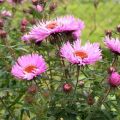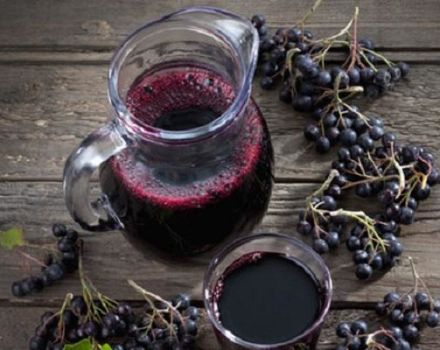Description of varieties of alpine asters, cultivation, planting and care
Alpine aster is loved by professional flower growers and amateurs. With a minimum of maintenance, this perennial flowering plant adorns gardens from spring to fall. Gardeners achieve continuous flowering with the right selection of varieties. There are plenty of them in the alpine variety of asters.
Characteristics of the variety
The species was domesticated in the 16th century. It unites a group of herbaceous perennial ground cover plants. The rhizome of the Alpine aster is branched, horizontal type. Shoots in height do not exceed 30 cm. Bottom branches are covered with oblong leaves with slight pubescence, linear above, small, sessile. The bushes reach 50 cm in diameter. Spreading, aster covers the ground with a colorful carpet, decorating it, preventing the growth of weeds and evaporation of moisture. The blooming period of mountain asters depends on the climate and variety.
Spring varieties delight with flowering from May to June, summer ones bloom in July and August. Autumn varieties bloom in the fall. Their bloom can last from the first days of September to the end of October.
Perennial inflorescences are single baskets. The color of the marginal flowers is ligulate, delicate, pastel. They can be pale or bright lilac, pure white, lilac, blue or violet.
In the middle there are tubular bright yellow flowers. The size of the inflorescences is 4-5 cm in diameter. They resemble chamomile in their appearance. July and August are the seed ripening period. Bushes meet winter green.
Varieties
Varieties differ in terms of flowering, color, size of inflorescences. There are a lot of them. It is worth getting to know the most popular ones.

White alps
The bushes are compact. Pure white flower baskets stand out brightly against the background of green leaves.
Albus
Low bushes - shoots length 15-20 cm Bloom from June to July. Inflorescences are dazzling white, short branches are densely covered with leaves.
Astra Blue
Blue aster has a very bright bloom. The color of the petals is blue, saturated. A plant with good frost resistance, does not freeze at -34 ° C.
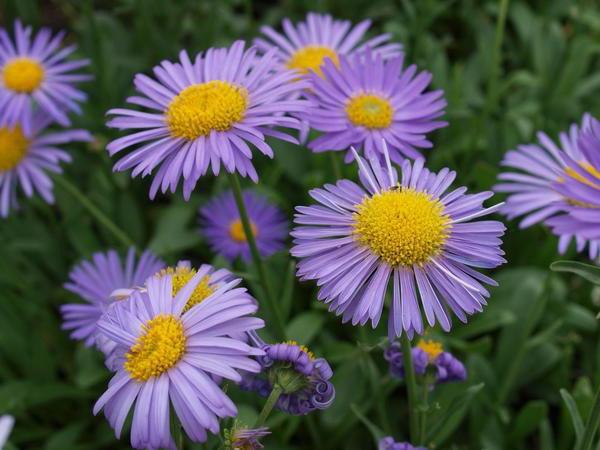
Illyria
The color of the inflorescences of Illyria is blue, pink, white, lilac. The bushes are low, they grow only 15-20 cm.
Alpine Aster Pink
A rapidly growing ground cover perennial. The size of the baskets is 4 cm. This variety is especially loved by landscape design professionals and amateurs. Flowering begins early, the first buds are laid in early May.
Alpine blue aster
Large-flowered perennial variety. The color of the inflorescences is blue, intense, size 6 cm. The bushes look spectacular due to the lush green rosette. It is formed from elongated basal leaves.
![]()
Gloria
The perennial has small rosettes with a diameter of 3 cm. Around the bright yellow core, narrow, blue petals diverge in rays.
Rosea
The size of the inflorescences is average - 4 cm in diameter. The color of the marginal petals is pink, tender. The height of the stems does not exceed 30 cm.
Astra perennial mixture
The flowers of this variety are large, semi-double, of different bright colors. A perennial mixture is chosen if you need to create a multi-colored composition.
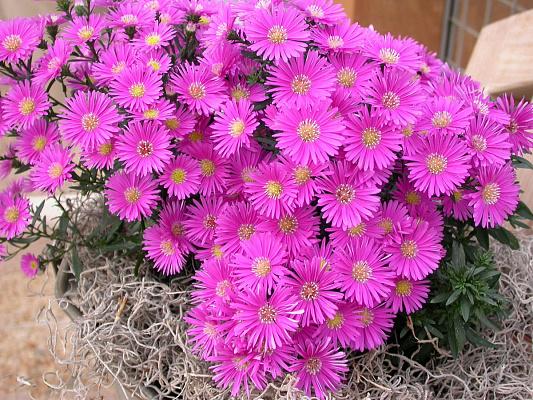
Goliath
Astra Goliath blooms in June. Flowers (diameter 6 cm) bloom throughout the month. Coloring of baskets in light purple tones. They are decorated with miniature 20 cm bushes. Goliath is planted on alpine slides.
Ruber
Red-pink color of flowers, unusual for the Alpine aster. The size of the baskets is average. The diameter can be up to 4 cm.
Superbus
Low 30 cm bushes are covered with small lilac-blue flowers. Their size does not exceed 3.5 cm.

Happy end
Abundant flowering lasts from May to June. Bushes are low (20-30 cm), covered with bright pink medium-sized flowers.
Dunkle schone
The flowers are of a beautiful purple color, up to 3.5 cm in diameter, planted on low stems of 30 cm.
Planting and growing a plant
Soil preparation is reduced to deep digging (30 cm), removing the roots of perennial weeds, increasing fertility and normalizing the acidity level. For this purpose, the following is added for digging:
- superphosphate 2-3 tbsp. l .;
- humus (vermicompost, compost) 3 kg / m²;
- 1 tbsp. dolomite flour.
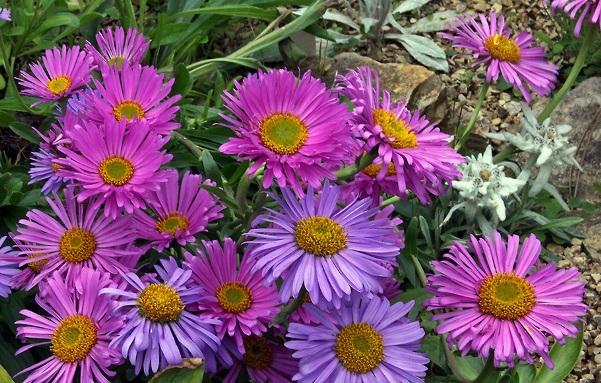
They choose a sunny place where rain and melt water does not linger. Alpine aster is grown by direct sowing of seeds in the ground and by seedling.
From seed
Alpine aster seeds sprout poorly. Collect them after flowering. They are planted before winter in a greenhouse with fertile soil. They are not buried. Sprinkle with humus (1 cm). The greenhouse in the spring is tightly covered with a film (glass) to create a greenhouse effect.
Aster seedlings, planted in autumn, dive. At the time of transplantation, they should have 2-4 true leaves. Flowering can be expected in the second year after sowing. Alpine aster seeds can be sown in open ground in May. This method is practiced by flower growers living in the southern regions. The seedling method is suitable for temperate climates.

Seedlings
Alpine aster seeds are sown for seedlings from March to April... Suitable soil mixture, composed of garden soil, sand, peat and humus, taken in a ratio of 1: 1: 1: 1. The seeds are buried by 0.5 cm. They are covered with humus. The container is covered with a film.
In the phase of 2-4 leaves, the seedlings dive into separate glasses. The containers are being prepared for planting:
- a hole is made in the bottom;
- expanded clay is poured;
- fill with soil.
The seedlings are covered with transparent plastic bottles, having cut off the bottom beforehand. Seedling care includes watering, feeding with biostimulants, supplementary lighting.
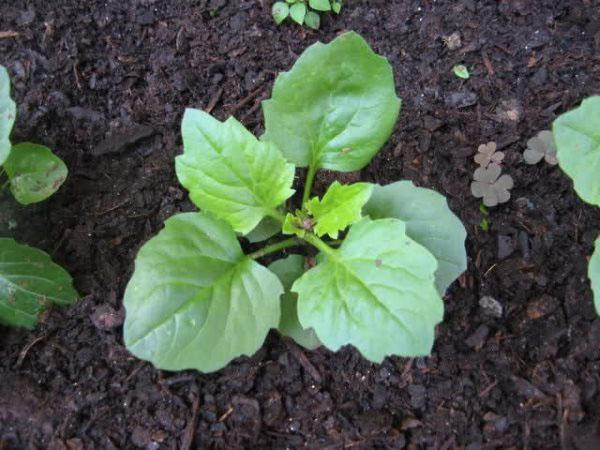
Boarding time
In May, aster seedlings are planted in a permanent place. A week before the transplant, they adapt to street conditions. They are taken out into the yard or on the balcony during the day. The first year of planting alpine asters for the winter are covered.
Plant care
Alpine aster does not lose its decorative effect for 5-7 years if there is minimal care for it. Perennials are watered abundantly (3 buckets per 1 m²), but not often. Waterlogging reduces immunity and causes fungal diseases.
During the season, the soil in the flowerbed is loosened to a depth of 4 cm, weeds are removed, the bushes are spud.
This helps to strengthen the root system, improve nutrition. Alpine aster does not like prolonged drought. The flowers lose their decorative effect, wither and dry. During flowering, faded inflorescences are cut out.Before the onset of frost, dried shoots are pruned and the soil is mulched with humus.

Fertilizing and feeding
Top dressing stimulates abundant and long flowering. They are held 3 times per season:
- At the beginning of the growing season with a solution of mineral fertilizers, 10 g of potassium sulfate, 20 g of carbamide, 50 g of superphosphate are taken for 10 liters of water.
- The granules of superphosphate and potassium sulfate are applied at the time of bud appearance, each is taken at 50 g / m².
- Repeat the previous top dressing at the peak of flowering.
Plant propagation
Alpine aster is easy to propagate vegetatively. Dividing the mother bush is the easiest option. Do it this spring. Pre-prepare the landing site. The bush is dug up, the root system is freed from the ground, divided into several parts.

Delenki are transplanted into prepared holes, watered. The soil around the bushes of alpine asters is mulched with needles, rotten sawdust or dry lawn grass. Reproduction of expensive elite varieties is carried out by cuttings. The method allows you to preserve all the varietal characteristics of the perennial.
For cuttings, take the upper part of the shoot (6-8 cm) of the alpine aster. The main condition is 2 points of growth on the branch. Planted in a greenhouse. It is filled with a mixture of peat, garden soil, sand, ash. The cuttings are deepened into the ground by 4 cm. With the help of the film, they create a comfortable greenhouse environment. After a month, young roots appear on the cuttings. The seedlings are transplanted into the garden.
Diseases and pests
All varieties of alpine asters are distinguished by stable immunity. Outbreaks of powdery mildew are provoked by damp weather and care errors:
- excessive watering;
- thickened fit;
- poorly chosen landing site.

For preventive treatments of perennials, the drug "Topaz" is used. Ornamental plants are treated with it twice. Both times before flowering. Consumption of funds for a 10 liter bucket of water - 2 ml. Diseased alpine aster bushes in the fall are sprayed with a solution of copper sulfate (10 l 50 g). Shoots are cut at ground level, burned. The soil is watered with Fitosporin-M solution.
Combination with other plants
In garden beds, a decoratively flowering perennial serves as an excellent background for annuals. The rich color palette of alpine aster varieties allows you to create excellent group compositions in blue, lilac or purple hues.
For example, the purple-flowered Dunkle Chenet alpine aster serves as an excellent backdrop for yellow-flowered plants:
- curb irises;
- euphorbia cypress and multiflower;
- loosestrife point.

On alpine hills, perennial alpine aster is planted next to stonecrops (large, prominent). Its graceful flowers blend well with delicate violets and large inflorescences of long-blooming geraniums. Blooming alpine aster looks favorably against the background of decorative leaves of badan. It increases the decorative properties of Japanese spirea, Thunberg barberry, white deren.
Alpine aster in landscape design
Professional landscape designers love to incorporate perennial alpine aster into their compositions. Do not forget about it and amateur gardeners. They use it in many ways. The main range of applications for alpine asters:
- design of artificial reservoirs;
- decoration of borders;
- addition of group compositions of ornamental shrubs;
- rocky hills;
- rock gardens;
- garden beds.
The popularity of the alpine aster has not diminished over the years. Easy care, large selection of varieties, rich color range, long flowering. This is just a small list of the advantages that make perennials attractive to flower growers of all levels.



